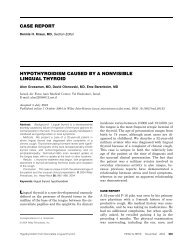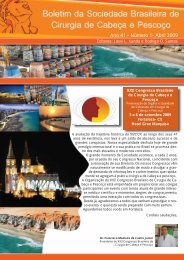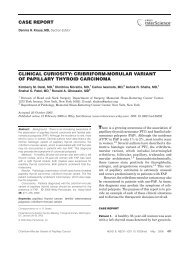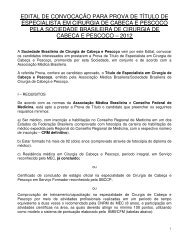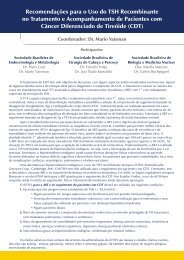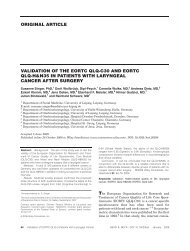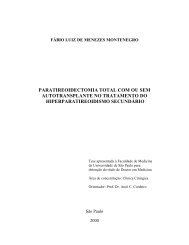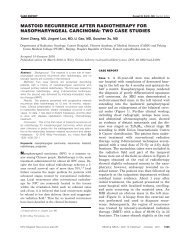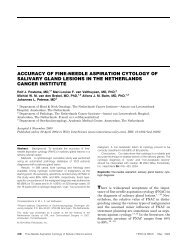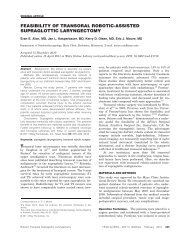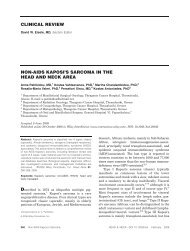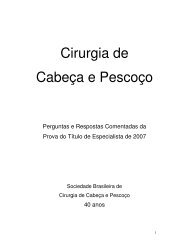Radiation-induced xerostomia
Radiation-induced xerostomia
Radiation-induced xerostomia
Create successful ePaper yourself
Turn your PDF publications into a flip-book with our unique Google optimized e-Paper software.
treatment of head and neck squamous carcinoma. Semin<br />
Radiat Oncol 2004;14:153–166.<br />
3. Wong RK, Jones GW, Sagar SM, Babjak AF, Whelan T.<br />
A Phase I–II study in the use of acupuncture-like transcutaneous<br />
nerve stimulation in the treatment of radiation-<strong>induced</strong><br />
<strong>xerostomia</strong> in head-and-neck cancer patients<br />
treated with radical radiotherapy. Int J Radiat<br />
Oncol Biol Phys 2003;57:472–480.<br />
4. Wescott WB, Mira JG, Starcke EN, Shannon IL,<br />
Thornby JI. Alterations in whole saliva flow rate <strong>induced</strong><br />
by fractionated radiotherapy. AJR Am J Roentgenol 1978;<br />
130:145–149.<br />
5. Liu RP, Fleming TJ, Toth BB, Keene HJ. Salivary flow<br />
rates in patients with head and neck cancer 0.5 to 25<br />
years after radiotherapy. Oral Surg Oral Med Oral Pathol<br />
1990;70:724–729.<br />
6. Taylor SE. Efficacy and economic evaluation of pilocarpine<br />
in treating radiation-<strong>induced</strong> <strong>xerostomia</strong>. Expert<br />
Opin Pharmacother 2003;4:1489–1497.<br />
7. Frydrych AM, Davies GR, Slack-Smith LM, Heywood J.<br />
An investigation into the use of pilocarpine as a sialagogue<br />
in patients with radiation <strong>induced</strong> <strong>xerostomia</strong>.<br />
Aust Dent J 2002;47:249–253.<br />
8. Eisbruch A, Kim HM, Terrell JE, Marsh LH, Dawson LA,<br />
Ship JA. Xerostomia and its predictors following parotidsparing<br />
irradiation of head-and-neck cancer. Int J Radiat<br />
Oncol Biol Phys 2001;50:695–704.<br />
9. Bruce SD. <strong>Radiation</strong>-<strong>induced</strong> <strong>xerostomia</strong>: how dry is<br />
your patient Clin J Oncol Nurs 2004;8:61–67.<br />
10. Peterson DE. Oral problems in supportive care: no longer<br />
an orphan topic Support Care Cancer 2000;8:347–348.<br />
11. Atkinson JC, Baum BJ. Salivary enhancement: current<br />
status and future therapies. J Dent Educ 2001;65:1096–<br />
1101.<br />
12. Jha N, Seikaly H, McGaw T, Coulter L. Submandibular<br />
salivary gland transfer prevents radiation-<strong>induced</strong> <strong>xerostomia</strong>.<br />
Int J Radiat Oncol Biol Phys 2000;46:7–11.<br />
13. Cancer Therapy Evaluation Program, Common Terminology<br />
Criteria for Adverse Events, Version 3.0, DCTD, NCI,<br />
NIH, DHHS. March 31, 2003. Available at: http://ctep.<br />
cancer.gov/reporting/ctc.html. Accessed January 27, 2006.<br />
14. Epstein JB, Robertson M, Emerton S, Phillips N, Stevenson-Moore<br />
P. Quality of life and oral function in patients<br />
treated with radiation therapy for head and neck cancer.<br />
Head Neck 2001;23:389–398.<br />
15. Papas AS, Joshi A, MacDonald SL, et al. Caries prevalence<br />
in xerostomic individuals. J Can Dent Assoc 1993;<br />
59:171–174;177–179.<br />
16. Oral Cancer Background Papers. National Strategic<br />
Planning Conference for the Prevention and Control of<br />
Oral and Pharyngeal Cancer, August 7–9, 1996, Chicago,<br />
Illinois. Available at: http://www.cdc.gov/oralhealth/pdfs/<br />
oc-bgpapers.pdf. Accessed May 16, 2006.<br />
17. Nagler RM, Baum BJ. Prophylactic treatment reduces<br />
the severity of <strong>xerostomia</strong> following radiation therapy<br />
for oral cavity cancer. Arch Otolaryngol Head Neck Surg<br />
2003;129:247–250.<br />
18. Chao KS, Majhail N, Huang C-J, et al. Intensity-modulated<br />
radiation therapy reduces late salivary toxicity without<br />
compromising tumor control in patients with oropharyngeal<br />
carcinoma: a comparison with conventional techniques.<br />
Radiother Oncol 2001;61:275–280.<br />
19. Lee N, Xia P, Quivey JM, et al. Intensity-modulated<br />
radiotherapy in the treatment of nasopharyngeal carcinoma:<br />
an update of the UCSF experience. Int J Radiat<br />
Oncol Biol Phys 2002;53:12–22.<br />
20. Bohuslavizki KH, Klutmann S, Brenner W, Mester J,<br />
Henze E, Clausen M. Salivary gland protection by amifostine<br />
in high-dose radioiodine treatment: results of a<br />
double-blind placebo-controlled study. J Clin Oncol 1998;<br />
16:3542–3549.<br />
21. Brizel DM, Wasserman T. The influence of intravenous<br />
amifostine on <strong>xerostomia</strong> and survival during radiotherapy<br />
for head and neck cancer: two-year follow-up of prospective<br />
randomized trial. J Clin Oncol 2004;22(14 suppl):<br />
5536.<br />
22. Schuchter LM, Hensley ML, Meropol NJ, et al. 2002<br />
update of recommendations for the use of chemotherapy<br />
and radiotherapy protectants: clinical practice guidelines<br />
of the American Society of Clinical Oncology. J Clin<br />
Oncol 2002;20:2895–2903.<br />
23. Hensley ML, Schuchter LM, Lindley C, et al. American<br />
Society of Clinical Oncology clinical practice guidelines<br />
for the use of chemotherapy and radiotherapy protectants.<br />
J Clin Oncol 1999;17:3333–3355.<br />
24. Koukourakis MI, Simopoulos C, Minopoulos G, et al.<br />
Amifostine before chemotherapy: improved tolerance<br />
profile of the subcutaneous over the intravenous route.<br />
Clin Cancer Res 2003;9:3288–3293.<br />
25. Johnstone PA, Niemtzow RC, Riffenburgh RH. Acupuncture<br />
for <strong>xerostomia</strong>: clinical update. Cancer 2002;94:<br />
1151–1156.<br />
26. Seikaly H, Jha N, McGaw T, Coulter L, Liu R, Oldring D.<br />
Submandibular gland transfer: a new method of preventing<br />
radiation-<strong>induced</strong> <strong>xerostomia</strong>. Laryngoscope 2001; 111:<br />
347–352.<br />
27. Chambers M, Garden A, Klies M, Martin J. <strong>Radiation</strong><strong>induced</strong><br />
<strong>xerostomia</strong> in patients with head and neck cancer:<br />
pathogenesis, impact on quality of life, and management.<br />
Head Neck 2004;26:796–807.<br />
28. Johnson JT, Ferretti GA, Nethery WJ, et al. Oral pilocarpine<br />
for post-irradiation <strong>xerostomia</strong> in patients with<br />
head and neck cancer. N Engl J Med 1993;329:390–395.<br />
29. Haddad P, Karimi M. A randomized, double-blind, placebo-controlled<br />
trial of concomitant pilocarpine with<br />
head and neck irradiation for prevention of radiation<strong>induced</strong><br />
<strong>xerostomia</strong>. Radiother Oncol 2002;64:29–32.<br />
30. Fisher J, Scott C, Scarantino CW, et al. Phase III quality-of-life<br />
study results: impact on patients’ quality of life<br />
to reducing <strong>xerostomia</strong> after radiotherapy for head-andneck<br />
cancer—RTOG 97–09. Int J Radiat Oncol Biol Phys<br />
2003;56:832–836.<br />
31. Salagen tablets (pilocarpine hydrochloride) [package<br />
insert]. Bloomington, Minn: MGI Pharma, Inc; 2003.<br />
32. Iwabuchi Y, Masuhara T. Sialagogic activities of SNI-<br />
2011 compared with those of pilocarpine and McN-A-343<br />
in rat salivary glands: identification of a potential therapeutic<br />
agent for treatment of Sjögren’s syndrome. Gen<br />
Pharmacol 1994;25:123–129.<br />
33. Evoxac capsules (cevimeline hydrochloride) [package<br />
insert]. Montvale, NJ: Daiichi Pharmaceutical Corporation;<br />
2005.<br />
34. Petrone D, Condemi JJ, Fife R, Gluck O, Cohen S, Dalgin<br />
P. A double-blind, randomized, placebo-controlled<br />
study of cevimeline in Sjögren’s syndrome patients with<br />
<strong>xerostomia</strong> and keratoconjunctivitis sicca. Arthritis Rheum<br />
2002;46:748–754.<br />
35. Fife RS, Chase WF, Dore RK, et al. Cevimeline for the<br />
treatment of <strong>xerostomia</strong> in patients with Sjögren syndrome:<br />
a randomized trial. Arch Intern Med 2002;162:<br />
1293–1300.<br />
36. Chambers MS, Posner MR, Jones CU, Weber RS, Vitti R.<br />
Two phase III clinical studies of cevimeline for postirradiation<br />
<strong>xerostomia</strong> in patients with head and neck cancer.<br />
Presented at the 2005 Annual Meeting of the American<br />
Society of Clinical Oncology. Abstract no. 5503. Available<br />
at: http://www.asco.org/ac/1,1003, 12-002643-00_18-0034-<br />
00_19-0031963,00.asp. Accessed August 15, 2005.<br />
<strong>Radiation</strong>-Induced Xerostomia HEAD & NECK—DOI 10.1002/hed January 2007 63



